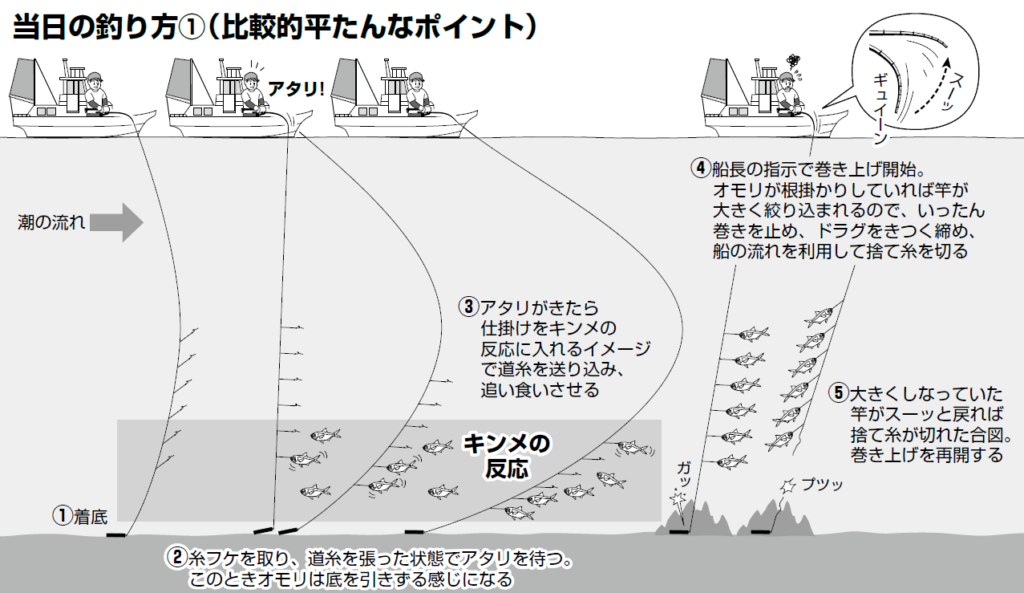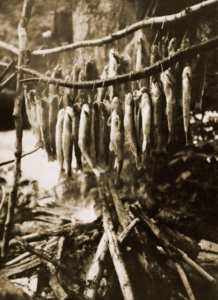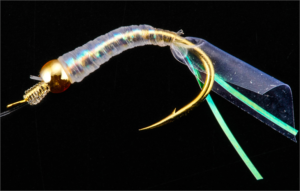Deep Sea Fishing for Gold Eyed Fish
Have you ever imagined catching a fish from the deep sea, nearly 800 m deep?
Can you imagine your rig does not reach the target depth range until 15 minutes later, with 2 kg of sinker?
There are a few interesting facts about Japanese deep sea fishing. Let us see the details of it.
Target fish
The most famous target is Kinmedai (Splendid alfonsino, Beryx splendens). The literal translation of Kinmedai is gold eyed sea bream. Its eyes are one of significant features in its appearance. Since it lives in the deep sea (deepest depth is 1,250 m), the eyes were evolved to see in low light water.

The Japanese name implies that this fish is related to sea breams, but this is quite different from sea breams. It is in the Beryx genus, which is a rather popular fish globally, where there is deep sea. But angling for it is not popular in other parts of the world. There are some deep sea fishing for redfish along Norway and near Greenland, however this fish is different species. If you know some areas where this fish is caught by anglers, would you please tell me? It interests me how they fish them.
Around Japan, this fish is popular for commercial fishing, in the places where the deep sea is close to the coast. These places are along the Izu islands, Ogasawara islands, Kochi, and East of Boso peninsula.
Kinmedai spawns in summer, in shallower depth than the depth at which adults live. One female gives about 2.8 million pieces of eggs, the size of about 1 mm. Interestingly, these eggs go up to the surface, and hatch on the surface of the sea. Then it grows up to 15 cm in length in one year, and gradually goes down deeper. After 4 years, it becomes an adult and ready for reproduction, with a size of approximately 40 cm.
Some individuals are said to live long, up to 15 years, and such fish grow up to 70 cm. The average size for fishing is about 40 cm.
These fish are carnivorous, and live on fish (such as Lantern fish, deep sea Lizardfish), squids (Firefly squid), and crustaceans.
In the video below, you can view Kinmedai in Shimoda Aquarium, located at the tip of Izu peninsula.
Fishing
The idea of fishing is very simple. Using a kind of flapper rig with baits, let it go to the bottom and wait for fish to eat the hooked bait. However, the complication starts from the depth at which we fish, especially when you target real depth (note; we have so called heavy tackle deep sea fishing, which I will show below, and light deep sea fishing which target up to 300 m.)
Firstly, the main line. To reach the target depth, we need to have the 1,200 m to 1,600 m of 12 gou of braided line (which is 0.60 mm thickness, or 160 lb for some brands). You need to have as much as this length, because, firstly, even when you fish at 800 m depth you need the line longer than the depth while the line curves from the water resistance, and secondly if there comes a problem of line at 500 m, then it may force you to stop fishing without not enough length of line.
With this main line, you need the reel to hold this line.

You can see that it is not a good idea to bring a spare reel for it, in this photo.
At the end of this main line, the rig like in the photo below is connected.

It has a 2 kg sinker, and 15 to 25 branches of hook leaders. Its total length is about 30 m. In this image, you may notice that the sinker shape is something unique. You are right, it is very different to conventional sinkers.
It is like this.

It is the thick wire for concrete building as a frame.
And just a simple task as throwing this rig into the sea is not easy. As a solution, we have a special tool to stow the branches and to make the rig presentation easier.

You can view how to send all these hooks in this video.
As the scene in which this filmed person looks very satisfied after it is completed is hinting at you, it is very important to do this procedure of presentation is the most important part of this Kinmedai fishing. To reach the bottom requires 10 to 15 minutes, and waiting for fish for about 30 to 40 minutes. One round of rig presentation in front of fish can be done for only once in an hour. It means that when you go out fishing for 6 hours, the chances for you to place your rig are only 6 times. To avoid the tangles of lines between anglers on the same boat, these presentations of each angler can only be allowed on the captain’s call. While the captain is controlling the boat in the best way to avoid tangles, the anglers throw their rigs one by one (normally from bow to stern.) When you make a mistake in releasing your rig, your turn is skipped and the next angler takes the turn. In this case, you have to wait for your next turn, that is one hour later.
Once the sinker is at the bottom, you let it stay at the bottom, and send your line further to drift your rigs to the side.

This allows your hooks to be in the depth range at where Kinmedai are. Then, after a while, you wind up your line forcefully, and it is often the case that it lets the sinker go at the snag. (This is one of the reasons why they use the steel construction wire, not to damage the environment.)
When the fish is on, you take the fish one by one, like hand fishing, for 30 meters. It ends up like the photo below.

You wonder what happened to the rig you use after this?
The rig with 20 or so hooks will be thrown away, and a new rig is attached for the next round.
Therefore, you have to prepare the rigs according to the number of presentations you make on a fishing trip.

Another hard work is that you have to put bait on every hook to be used. This has to be done the night before the fishing day. You can calculate, 20 hooks rig x 6 rounds equals 120 hooks.

The baits are squid, or sliced fish meat. As a fish meat bait, mackerel, salmon or bonito can be used with the skin on the meat. Some use semi dried fish meat to hold on the hook longer (it dries a little anyway, while hooking bait requires tremendous time…)
The attraction
You can imagine that Japanese people go for this fish to pursue one big reason; eating.


Kinmedai is the rare fish to find around our daily lives, for most Japanese people. But its taste attracts them, and it makes the value so high that anglers are crazy for it.
It has a certain level of fat content, which gives you a thicker taste, on top of the freshness of white meat fish.
You can quickly get the idea of this fish from the site below.
https://www.kikkoman.com/en/cookbook/glossary/kinmedai.html
To see or to eat is to believe. When you visit Japan, please try to find cuisine with Kinmedai, and remember about the unique fishing for it.

